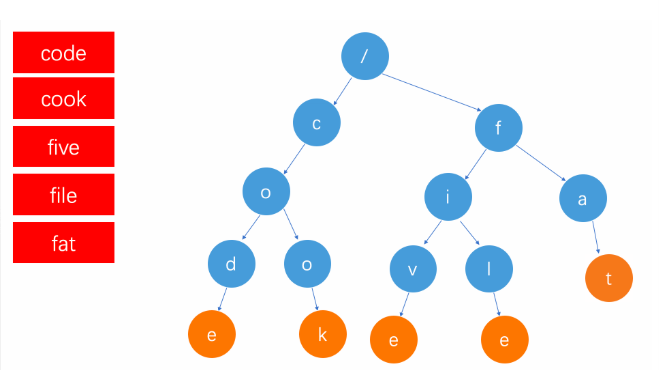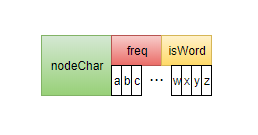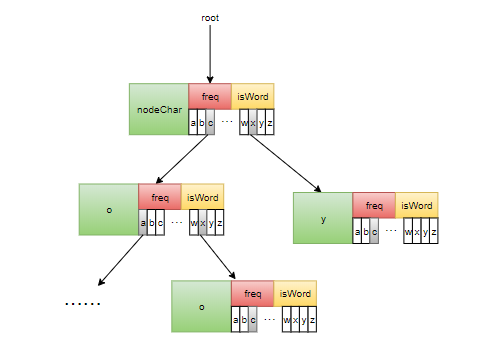共计 2121 个字符,预计需要花费 6 分钟才能阅读完成。
Trie 树
据不完全统计,世界上现存英语单词的数量为 17 万到 100 万不等。假设现在要你写一个词典 APP,要求能够快速检索、删除、添加单词,。显然你很容易想到两种方案:
- 将所有单词按字典序排列,在按二分搜索来查询。
- 奖励首字母索引表,在各索引项表内按字典序排序单词,再在当中按二分搜索查询。
但无疑上述方案的要求略高,需要大量的连续空间来存储数据,而且不方便添加删除操作。
这时 Trie 树便发挥作用了,我们可以用 Trie 树来存储单词数据,树结构不需要大量连续的存储空间而且查询、添加结点、删除结点的操作的时间复杂度很小为 $O(\log_{2}{N})$。
举个例子:
假设存储
$$[{"code","cook","five","file","fat"}]$$
这几个单词。其逻辑结构为:

Trie 树的实现
结点结构:

struct TrieNode {
char nodeChar;// 该结点表示的字符
int freq;// 出现的频率
bool isWord; // 单词结点结束标记
vector<TrieNode*> childNode;// 先一个结点的指针
TrieNode()// 初始化结点
{
freq = 0;
isWord = false;
childNode = vector<TrieNode*>(26,NULL);
}
};树的大致结构:

- 根节点的 nodeChar 不存储字符,其字符表示位于指针数组中,指针数组的某元素不空则表示存在以其为首字符的单词。
添加操作
// 添加操作
void addWord(TrieNode* root, string word, int k)
{if(k >= word.size()) return;
// 将 word 的首字母插入到 root 的哪一个分叉中
int index = word[k] - 'a';
// 若该树为空,插入新结点
if(root->childNode[index] == NULL)
{root->childNode[index] = new TrieNode();
root->childNode[index]->nodeChar = word[0];
if(k == word.size()-1)
{
// 终端结点标记
root->childNode[index]->isWord = true;
}
addWord(root->childNode[index], word, k+1);
}
else
{if(k == word.size()-1)
{root->childNode[index]->isWord = true;
}
// 递归添加结点
addWord(root->childNode[index], word, k+1);
}
}查询操作
// 查询操作
bool searchWord(TrieNode* root, string word)
{
TrieNode* p = root;
int i;
for(i = 0;i < word.size() && p != NULL;i++)
{int index = word[i] - 'a';
if(p->childNode[index] == NULL)
{return false;}
else
{if(i == word.size()-1)
p->childNode[index]->freq++;
p = p->childNode[index];
}
}
if(i == word.size() && p->isWord)
return true;
else return false;
}删除操作
删除操作比较复杂,分三种情况:
- 删除整个单词(该单词的尾结点为叶子节点,且该单词独占一条路径)
- 删除前缀词(该单词的尾结点非叶子节点)
- 删除分支单词(该单词的尾结点为叶子节点但存在于其他单词共用的路径)
bool isLeave(TrieNode* node) {for(int i = 0;i < 26;i++) {if(node->childNode[i] != NULL) {return false;} } return true; } void deleteWord(TrieNode* root, string word, int k) {if(k >= word.size()) return; cout << "delete into " << word[k] << endl; int index = word[k] - 'a'; if(root->childNode[index] == NULL) return; else { cout << 'd' << endl; deleteWord(root->childNode[index], word, k+1); if(isLeave(root) && !root->isWord) { cout << "dc" << endl; delete root; root = NULL; } else if(k == word.size()-1 && !isLeave(root)) { root->isWord = false; cout << "dd" << endl; } } } bool DeleteKey(TrieNode *root, string word) {if(searchWord(root, word)) {deleteWord(root, word, 0); return true; } return false; }
正文完